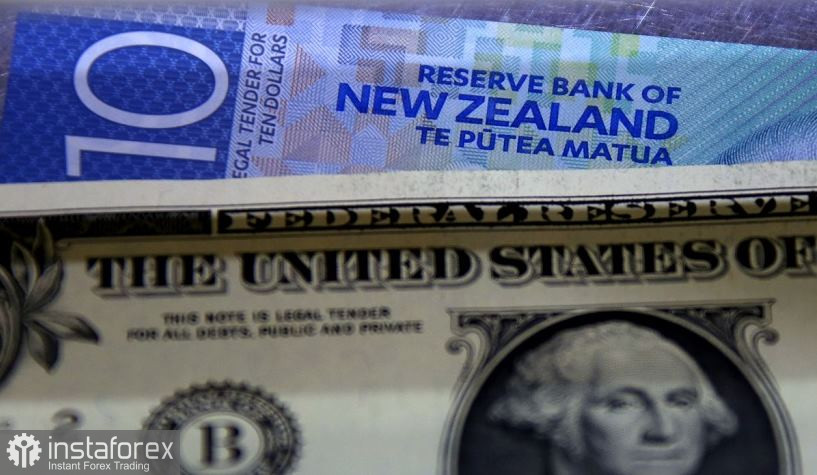Today, the Reserve Bank of New Zealand summed up the results of its November meeting, which is the last one this year. According to preliminary forecasts, the RBNZ was supposed to raise the interest rate by 25 basis points, that is, to the level of 0.75%. And the New Zealand regulator did not disappoint, fully meeting the expectations of most experts. The NZD/USD bears took advantage of the situation and updated the 6-week price low, falling to the level of 0.6890.
Having raised the interest rate, the RBNZ said that it now "has time for reflection", hinting at maintaining a wait-and-see position in the near future. At the same time, the Governor of the regulator Adrian Orr maintained a hawkish attitude, noting that the rate should be 2.5% by the end of 2023.
According to general forecasts (which are consistent with the forecasts of the New Zealand Central Bank), the next round of interest rate hikes will take place at the first meeting of 2022 in February. However, given Orr's phrase that the RBNZ now "has time for reflection", it can be assumed that the Central Bank will return to this issue at the second meeting of 2022, particularly in April. In any case, the fact remains that the Reserve Bank of New Zealand is pursuing the most aggressive policy among the central banks of the leading countries of the world. Many fundamental factors contribute to this: starting from the epidemiological situation in the country (85% of the population is fully vaccinated), ending with the growth of key macroeconomic indicators.
It is worth noting that the unemployment rate in New Zealand in the third quarter of this year declined to 3.4% – this is the best result in the last 13 years. Most experts expected to see this indicator at 3.9%. The number of employed increased immediately by 2% in quarterly terms, with a growth forecast of up to 0.4%. As for annual terms, the component also came out in the "green zone", surging to 4.2% with a growth forecast of 2.7%. The share of the economically active population also increased to 71.2%, with the previous value being 70.5%.
With regard to the dynamics of New Zealand inflation, we can also talk about record values here. The consumer price index in the third quarter of this year rose to 2.2% qoq. The indicator has updated a 10-year record – the last time the CPI was at a similar height (in quarterly terms) was in early 2011. On an annualized basis, the index also came out in the "green zone", at 4.9%. Both components of the release have been showing upward dynamics for several consecutive quarters, reflecting an increase in price pressure.
If this trend continues in the fourth quarter of this year, there is no doubt that the RBNZ will raise the rate by another 25 basis points at the beginning of 2022. At least, many experts do not doubt this, especially amid the final communique of today's meeting. The accompanying statement states that the Central Bank needs to continue reducing stimulus measures in order to maintain price stability and maintain maximum employment.

Nevertheless, it is possible to talk about the downward prospects of the NZD/USD pair now with some caution. The US dollar is a serious and insidious opponent, strengthening its position not only due to the growth of hawkish expectations but also due to the strengthening of anti-risk sentiment in the market. Traders are reacting to the collapse of the Turkish lira, which updated the historical low yesterday against the US dollar. This happened after Turkish President Recep Erdogan approved the actions of the Central Bank, which continues to lower the interest rate level, despite rising inflation in the country. The Turkish leader promised that he would not give in to "global financial acrobats" calling for an increase in interest rates.
It should be noted here that Erdogan has repeatedly called on the national Central Bank to reverse action, that is, to lower rates. In March of this year, another "hawkish" decision of the head of the Central Bank was the last straw for the president, after which the head of the Turkish state replaced the "hawkish" Agbal with the "dovish" Shahab Kavcioglu. He fully justified Erdogan's hopes – the Central Bank lowered the rate to 18% in September, to 16% in October, and to 15% in November. Meanwhile, inflation in the country has approached 20%.
Another "Black Monday" for the Turkish lira has also affected other currency pairs. There were concerns among traders that such shock therapy would be over in other financial markets. Against the background of such assumptions, the US dollar has become in high demand as a protective asset.
Such an ambiguous fundamental background for the NZD/USD pair suggests that sales should be treated with caution. The New Zealand dollar impulsively declined to the lower line of the Bollinger Bands indicator on the daily chart (0.6890 mark), but could not break through this price barrier. It is advisable to consider short positions only when consolidating below this support level. In this case, the next (main) support level of 0.6800 will appear on the range – this is the price low of the current year.
 English
English 
 Русский
Русский Bahasa Indonesia
Bahasa Indonesia Bahasa Malay
Bahasa Malay ไทย
ไทย Español
Español Deutsch
Deutsch Български
Български Français
Français Tiếng Việt
Tiếng Việt 中文
中文 বাংলা
বাংলা हिन्दी
हिन्दी Čeština
Čeština Українська
Українська Română
Română


